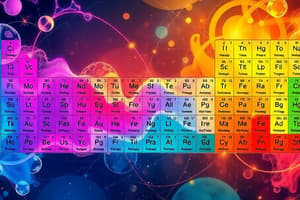Podcast
Questions and Answers
¿Qué propiedades suelen tener los metales en términos de energía de ionización y conductividad?
¿Qué propiedades suelen tener los metales en términos de energía de ionización y conductividad?
Los metales suelen tener bajas energías de ionización y buena conductividad.
¿Cómo se diferencian los no metales de los metales en términos de energía de ionización y conductividad?
¿Cómo se diferencian los no metales de los metales en términos de energía de ionización y conductividad?
Los no metales suelen tener altas energías de ionización y baja conductividad.
¿Qué propiedades comparten los metaloides con los metales y los no metales?
¿Qué propiedades comparten los metaloides con los metales y los no metales?
Los metaloides comparten propiedades de ambos, metales y no metales.
¿Qué papel juegan el tamaño atómico, la electronegatividad y la energía de ionización en la disposición de los elementos en la tabla periódica?
¿Qué papel juegan el tamaño atómico, la electronegatividad y la energía de ionización en la disposición de los elementos en la tabla periódica?
¿Qué similitudes existen entre los elementos de un mismo grupo en la tabla periódica?
¿Qué similitudes existen entre los elementos de un mismo grupo en la tabla periódica?
¿Cuál es el papel de los números pares al dividirlos por 2?
¿Cuál es el papel de los números pares al dividirlos por 2?
¿Qué tipo de resultado se obtiene al multiplicar dos números pares?
¿Qué tipo de resultado se obtiene al multiplicar dos números pares?
¿Qué suele suceder al multiplicar un número impar por un número par?
¿Qué suele suceder al multiplicar un número impar por un número par?
¿Por qué es importante el concepto de números pares en estructuras algebraicas?
¿Por qué es importante el concepto de números pares en estructuras algebraicas?
¿Cuál es la relevancia de comprender las diferencias entre números pares e impares en matemáticas?
¿Cuál es la relevancia de comprender las diferencias entre números pares e impares en matemáticas?
Study Notes
Periodic Table Properties
The periodic table is one of the most significant achievements in chemistry, allowing scientists to predict and explain patterns of chemical behavior. It organizes elements based on their atomic numbers, electron configurations, recurring chemical properties, and other factors. Each element has its unique position within the table due to these characteristics. Here's what you need to know about the periodic table and its properties:
Historical Development
The modern periodic table was first proposed by Dmitri Mendeleev during his investigation into the elements known at the time. He noticed repeating trends among the elements and used this information to create a tabular arrangement of the elements, which he published in 1869. Although there have been numerous changes in details since then, the overall organization remains much the same as when it was first introduced.
Structure of the Periodic Table
The periodic table consists of rows called periods and columns called groups. Elements with similar properties tend to occur in the same grouping. There are currently 18 groups, each containing between 1 and 18 elements. Periods typically range from 2 to 7, although some tables may have more extended periods. The elements are arranged in order of increasing atomic number.
Classification of Elements
Elements can be classified in several ways using various systems. One such system divides elements into metals, nonmetals, metalloids (or semimetals), and free radicals based on their physical and chemical properties. Metals usually have low ionization energies, high electronegativities, and good conductivity. Nonmetals generally exhibit high ionization energies, low electronegativities, and poor conductivity. Metalloids share some properties of both metals and nonmetals.
Arrangement of Elements
Understanding the arrangement of elements in the periodic table helps us appreciate how different elements interact and react with one another. Atomic size, electronegativity, and ionization energy all play crucial roles in determining where elements belong in the table. For example, elements in the same group have similar sizes, while elements in the same period have similar atomic sizes and ionization energies.
In conclusion, the periodic table is a vital tool in understanding chemistry and the world around us. Its properties and structure allow for accurate predictions and explanations of chemical behaviors, making it indispensable in scientific research and education.
Studying That Suits You
Use AI to generate personalized quizzes and flashcards to suit your learning preferences.
Description
Descubre la importancia de la tabla periódica en química, cómo se organiza según números atómicos y configuraciones electrónicas, y las propiedades químicas recurrentes de los elementos. Aprende sobre el desarrollo histórico, la estructura de la tabla periódica, la clasificación de elementos como metales, no metales y metaloides, y cómo se disponen los elementos en función de su tamaño atómico, electronegatividad y energía de ionización.




